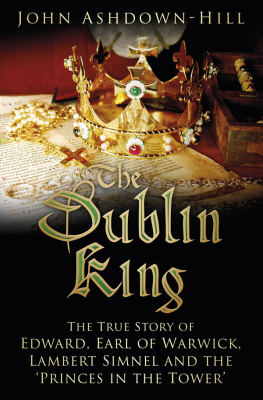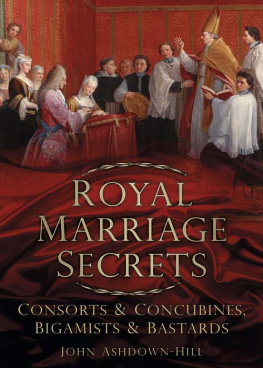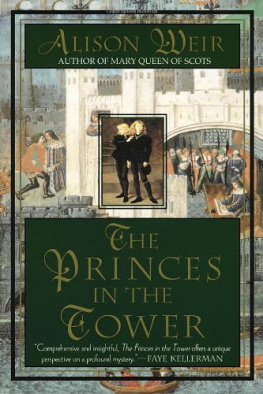

The Punishment of Lamnel (or Wermkin), by John Reynolds (W.C. Sellar & R.J. Yeatman, 1066 and All That, London 1930, 1963, reproduced by courtesy of Methuen & Co. Ltd).

.
Full of deceit, always, and in every way, is the nature of man.
Aristophanes,  (The Birds), lines 4512.
(The Birds), lines 4512.
In memory of my dear cousin, Valerie Ashdown (Enkelaar) 19312014 whose life also linked England and the Low Countries.
First published in 2015
The History Press
The Mill, Brimscombe Port
Stroud, Gloucestershire, GL5 2QG
www.thehistorypress.co.uk
This ebook edition published in 2017
All rights reserved
John Ashdown-Hill, 2015, 2017
The right of John Ashdown-Hill to be identified as the Author of this work has been asserted in accordance with the Copyright, Designs and Patents Act 1988.
This ebook is copyright material and must not be copied, reproduced, transferred, distributed, leased, licensed or publicly performed or used in any way except as specifically permitted in writing by the publishers, as allowed under the terms and conditions under which it was purchased or as strictly permitted by applicable copyright law. Any unauthorised distribution or use of this text may be a direct infringement of the authors and publishers rights, and those responsible may be liable in law accordingly.
EPUB 978 0 7509 6316 9
Original typesetting by The History Press
eBook converted by Geethik Technologies
Contents
Acknowledgements
I should like to give my profuse thanks to those people in Ireland who, in various ways have helped me with my research. These include James Harte, Samm Coade and the other very kind staff of the enormously helpful Irish National Library, together with Professor McGing and Eileen Kelly of Trinity College, Dublin, and Kate Manning, of the Archives of University College, Dublin. I should also like to record a heartfelt posthumous thank you to Professor F.X. Martin, whose publication on Lambert Simnel first brought to my attention the existence of the surviving (albeit damaged) seal of the Dublin King.
I also have debts of gratitude in the U.K. I am enormously grateful to Dr Emily Kearns, who has very kindly checked my Latin (and Greek) translations in an attempt to ensure that no mistakes have crept in. My thanks are also due to the Essex Library service; to the staff of the Albert Sloman Library of the University of Essex; to Marie Barnfield, of the Richard III Society Non-fiction Papers Library; to the Staff of the Guildhall Library in London; and to Dave Perry, who helped me check through the Great Chronicle of London. Dave Perry and Annette Carson also checked the proofs of my text to remove typographical and other errors and ensure that my meaning was clear. Finally, my thanks also go to the living Essex Lambert Simnel who figures on Facebook, and who responded to my enquiry even though, sadly, his Facebook identity proved to be a pseudonym!
Introduction
Anyone seeking information about Lambert Simnel will easily discover that this rather unusual name refers to a late fifteenth-century pretender to the English throne. His career is seen as marking one of the final chapters of the so-called Wars of the Roses. The word pretender was originally a neutral term, merely meaning claimant. Thus, for example, the eighteenth-century Old Pretender and Young Pretender, though they made the unspeakable error of professing the wrong religion in terms of the England (and Britain) of their day, were certainly not in any sense false claimants to the throne. However, since the word pretender tends to be applied mainly to failures, it is now often seen as implying fake claimant, and this is definitely its generally perceived meaning in the case of Lambert Simnel. To most historians and to most of the general public Simnel was nothing more than an impostor.
The name relates to a boy put forward by Yorkist leaders as the figurehead for their first campaign against Henry VII, a year or two after the latters usurpation of the English throne in 1485. Incidentally, the word usurpation is another term which might benefit from some analysis. Properly, it means taking something over without a legal right. Yet although it has frequently been applied to the accession of Richard III (who, in reality, was offered the throne of England by the Three Estates of the Realm), curiously it is not generally applied to the violent seizures of power by Edward IV and Henry VII. Apparently in the case of a violent but successful seizure of power, the use of the term usurpation is not now seen as appropriate!
If the general perception of Lambert Simnel, the impostor is correct, the story of his 1487 adventure would be the first (and perhaps the only) incident in English history which involved a serious attempt at putting a totally fake claimant on the throne.
Since his alleged name of Lambert Simnel sounds somewhat improbable and has, in fact, sometimes been described as having a pantomime-like quality it has also been suggested by some historians that the boy might perhaps have had a non-English (possibly Flemish) ancestry. However, no proof has ever been produced to show that the surname Simnel originated in the Low Countries. In fact, the true evidence relating to the history of this surname will be revealed in .
In addition to positing a misleading modern invention in respect of the origins of the name Lambert Simnel, the widespread current standard interpretation of his story also often includes misleading statements relating to the lives and deaths of the so-called princes in the Tower. Actually, there is no real evidence that those two sons of Edward IV were murdered. Although it has been widely credited, the very detailed but unsubstantiated account of their slaughter written by Sir Thomas More dates from thirty years after the alleged event. In fact Thomas More himself was an insignificant boy of five in 1483, when the drama which he later reported in such detail was alleged to have occurred.
As for the contemporary fifteenth-century sources on the fate of the princes, they are conflicting, and very much lacking in detail. However, as we shall see, according to one near-contemporary source, the 1487 pretender was himself supposed to have claimed to be the younger of the two. It is true that, when we examine it carefully, the evidence on this point in relation to Lambert Simnel will prove to be somewhat questionable. Nevertheless, there is no doubt whatever that a subsequent Yorkist pretender, known to history as Perkin Warbeck, advanced a similar claim on his own account, and was quite widely believed. Thus the Warbeck case proves incontrovertibly that the death of the sons of Edward IV was by no means universally accepted as a fact in the late 1480s and the 1490s. Indeed, Sir Thomas More himself later acknowledged that belief in the survival of at least one of them still persisted in his day.
The legal situation in respect of the so-called princes was somewhat complex. An unofficial Parliament (meeting of the Three Estates of the Realm) in 1483, followed subsequently by the official Parliament of 1484, formally declared these two boys and their sisters illegitimate and unable to claim anything by inheritance. Thus from the summer of 1483 until the summer of 1485 (i.e. during the reign of Richard III) neither of Edward IVs sons was a genuine, legal prince in consequence of which, neither of them possessed any claim to the English crown. This legal decision was significant in several ways, as we shall see later. However, one important side effect was that Richard III who had been recognised as the legitimate sovereign by the same piece of legislation would have had absolutely no logical reason for killing these two sons of his elder brother in order to obtain the throne, since they had already officially been declared bastards and excluded from the line of succession.
Next page














 (The Birds), lines 4512.
(The Birds), lines 4512.